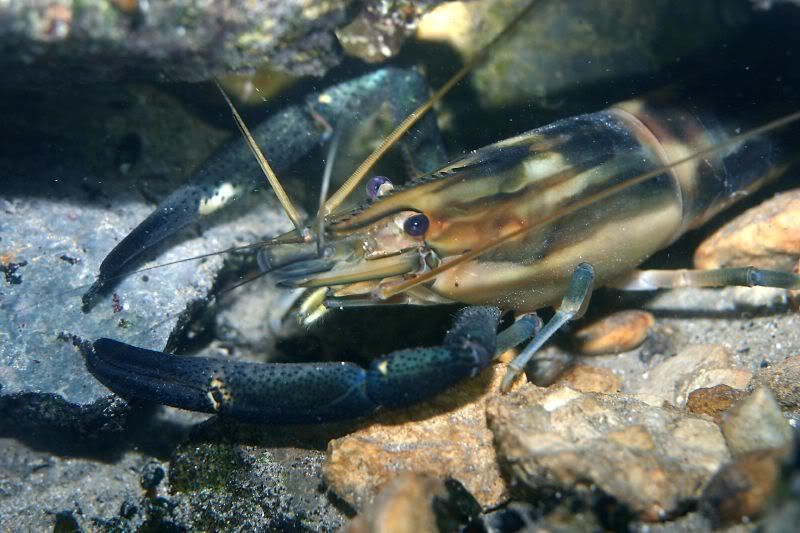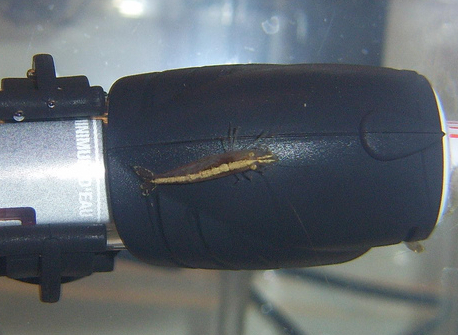Native Shrimp
#1
 Guest_ZeeZ_*
Guest_ZeeZ_*
Posted 16 May 2012 - 02:48 PM
Are there any out there?
#2
 Guest_Skipjack_*
Guest_Skipjack_*
Posted 16 May 2012 - 04:14 PM
#3
 Guest_gerald_*
Guest_gerald_*
Posted 16 May 2012 - 05:20 PM
#4
 Guest_EricaWieser_*
Guest_EricaWieser_*
Posted 16 May 2012 - 05:26 PM
There are some pretty cool pictures here: http://www.petshrimp...glassshrimp.php
I like how you can see them eat their food.
Be careful, though, they are definitely jumpers. If they don't like the water they've been put in and you don't have a complete lid on your tank, you will find them outside the tank all across the room. At 10 cents a shrimp it's easy to try again, this time with better water quality and more live plants.
#5
 Guest_Ouassous_*
Guest_Ouassous_*
Posted 17 May 2012 - 12:33 AM
It seems like atyids (members of the family containing cherry shrimp, Amanos, and so on) were more diverse in prehistoric North American surface waters in prehistory, since they left relatives in subterranean refugia in the eastern U.S. (Palaemonias alabamae from caves in Madison County, Atlanta, and P. ganteri from Mammoth Cave, Kentucky). The only surface-water forms around today are Syncaris pacifica and S. pasadenae (both from California, the second probably extinct), plus -- in Florida -- a Potimirim (this genus looks pretty similar to Old World Caridina) and at least one fan shrimp, Atya sp. There could be others, but they probably don't make it past very southern Florida since they'd have to be predominantly Caribbean species at the very northern edge of their distributions.
The continental U.S. is definitely home to some very interesting Macrobrachium -- the three species native to the Carolinas are M. acanthurus, M. ohione (which is, or used to be, very widespread in the Mississippi system, as far north as Ohio and Illinois), M. olfersi. Elsewhere in the Gulf Coast and southern Atlantic states you'll also find M. carcinus (adults get huge and make very impressive pet material), and FL has M. heterochirus.
The warmer areas may also have feral M. rosenbergii from the Oriental tropics (aquaculture escapees), and the East Asian Exopalaemon modestus is established in some of the west coast states.
Edited by Ouassous, 17 May 2012 - 01:07 AM.
#6
 Guest_Usil_*
Guest_Usil_*
Posted 17 May 2012 - 12:57 AM

Here is a good source to read.
http://decapoda.nhm....25682/25682.pdf
Usil
Edited by Usil, 17 May 2012 - 01:10 AM.
#7
 Guest_ZeeZ_*
Guest_ZeeZ_*
Posted 18 May 2012 - 11:09 AM
Very cool photos, Erica! That explains why Ghost Shrimp are so cheap here... they're native. Doh.
So there are no native freshwater filter feeders? Wood Shrimp or anything?
Edited by ZeeZ, 18 May 2012 - 11:10 AM.
#8
 Guest_gerald_*
Guest_gerald_*
Posted 18 May 2012 - 01:00 PM
#9
 Guest_Ouassous_*
Guest_Ouassous_*
Posted 18 May 2012 - 07:50 PM
So there are no native freshwater filter feeders? Wood Shrimp or anything?
Here's a photo of a Potimirim that I collected in Puerto Rico (at least one related species makes it into southern Florida):

And here's one that someone else took of another Puerto Rican animal alongside a cherry shrimp.
I'm aware of a single report of a young Atya sp. being collected at an estuarine or marine site in Florida (post-larvae probably sometimes linger in saline water before migrating upstream). Would probably have been Atya lanipes:

Both of these probably have a fairly restricted distribution in the warmer parts of the state. There's a chance that the dwarf Caribbean fan shrimp Micratya poeyi occurs intermittently there too, but it's never been documented from the contiguous U.S. to date. Some tank and field shots of my old specimens (also Puerto Rican):




Xiphocaris elongata (Puerto Rico -- same situation as far as FL is concerned ... maybe less likely, actually):

To be honest, things don't get too diverse as far as surface-water shrimp are concerned until you get into Mexico or the Antilles. That said, the few Macrobrachium spp. you'll encounter are super interesting.

M. faustinum, close relative of M. olfersi in the Carolinas

Young M. carcinus
Edited by Ouassous, 18 May 2012 - 08:06 PM.
#10
 Guest_gzeiger_*
Guest_gzeiger_*
Posted 19 May 2012 - 03:24 PM
Palaemonetes are great too, but Erica is the first I've heard claim success at breeding them. They are a wonderful addition to a tank with fish small enough to not eat them.
#11
 Guest_ZeeZ_*
Guest_ZeeZ_*
Posted 21 May 2012 - 10:40 AM
Maybe something along the likes of Redear... but those are predatory as well.
And that faustinum looks like it can eat anything it wants that that claw.
Are any of those able to be kept with others of their own species or are they like crayfish and need to be kept one per tank?
I love the Caribbean fan shrimp. That photo them in the water flow and in the net is amazing. Very nice patterns as well!
Edited by ZeeZ, 21 May 2012 - 10:44 AM.
#12
 Guest_smokehound_*
Guest_smokehound_*
Posted 20 January 2013 - 03:30 AM
Looks like dinnerHow about this fresh water river shrimp: Big-claw river shrimp (Macrobrachium carcinus) from Texas.
Here is a good source to read.
http://decapoda.nhm....25682/25682.pdf
Usil
#13
 Guest_mnemenoi_*
Guest_mnemenoi_*
Posted 03 March 2013 - 08:52 AM
#14
 Guest_Dan Johnson_*
Guest_Dan Johnson_*
Posted 04 March 2013 - 03:10 PM
#15
 Guest_mnemenoi_*
Guest_mnemenoi_*
Posted 04 March 2013 - 03:24 PM
0 user(s) are reading this topic
0 members, 0 guests, 0 anonymous users







